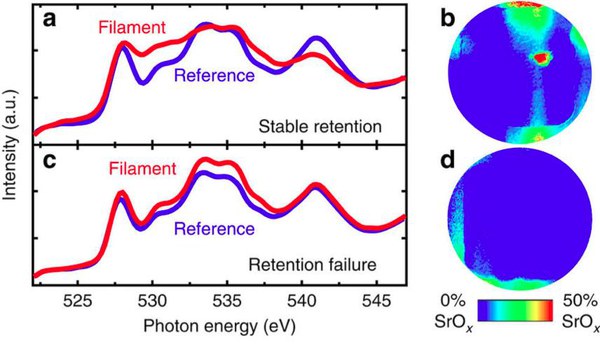Fundamentals of Redox Processes
Resistive switching materials show a change in resistivity under application of an electric stimulus, often over several orders of magnitude. This nonlinear behavior is of high interest for possible applications in information technology, as building block for non-volatile memories as well as for novel logic architectures.

In many oxide materials, a valence change mechanism drives the microscopic origin of the change in resistivity. Within the collaboration framework of SFB917 , the fundamental properties of these materials have been investigated since 2011.
In close collaboration with colleagues from PGI-7 the model system SrTiO3 (STO) was investigated in detail. A main challenge posed by STO lies in the fact that here the resistive switching proceeds via the formation of nanoscale conductive filaments.
Employing different microspectroscopy methods with soft as well as hard x-rays we were able to directly observe the relevant redox processes within the filamentary areas [1].

Moreover, we could unambiguously connect these to the local formation of oxygen vacancies and a corresponding valence change of the Titanium ions.
The necessity to access the active material below metal electrodes in functioning devices stimulated the development of Hard X-Ray Photoemission Electron Microscopy (HAXPEEM) [2,3].
This method, which is at the moment being established as a permanent endstation at the new beamline P22 at synchrotron PETRAIII in Hamburg, combines the lateral resolution of photoemission microscopy with the extended probing depth and spectroscopic information of hard x-ray photoemission spectroscopy.
Ref:
[1] C. Baeumer, C. Schmitz, A.H.H. Ramadan, H. Du, K. Skaja, V. Feyer, P. Muller, B. Arndt, C.-L. Jia, J. Mayer, R.A. De Souza, C.M. Schneider, R. Waser, and R. Dittmann, Spectromicroscopic insights for rational design of redox-based memristive devices. Nat Commun, 6, 9610 (2015)
[2] C. Wiemann, M. Patt, S. Cramm, M. Escher, M. Merkel, A. Gloskovskii, S. Thiess, W. Drube, and C. M. Schneider, Probing buried layers by photoelectron spectromicroscopy with hard x-ray excitation. Appl. Phys. Lett. 100, 223106 (2012)
[3] M. Patt, C. Wiemann, N. Weber, M. Escher, A. Gloskovskii, W. Drube, M. Merkel, and C.M. Schneider, Bulk sensitive hard x-ray photoemission electron microscopy. Rev. Sci. Instrum., 85, 113704 (2014)
Chemistry at solid-liquid interfaces
Many of the redox applications rely on processes taking place at solid-liquid interfaces. This is especially true for energy-related devices – batteries, supercapacitors, electrolysis cells, fuel cells, etc. Due to their very nature, liquid samples are incompatible with ultra-high vacuum probes unless special experimental measures are taken.
On the other hand, photoemission spectroscopy is a very powerful tool for investigating interfaces, since, beyond the conventional elemental and chemical analysis, it is also sensitive to electric fields and can be used for a direct mapping of electrical potentials by observing core-electrons energy shifts.
However, one missing aspect is depth selectivity, which in a traditional X-ray photoemission is only achieved via the exponential attenuation of the photoemission signal. This can be overcome by a spatially non-uniform excitation, i.e., an X-ray modulation using the standing wave approach.

Recently, PGI-6 in a collaboration with LBNL developed SWAPPS (standing-wave ambient pressure photoemission spectroscopy) a powerful tool for studying solid-liquid interfaces. The first-of-a-kind SWAPPS study was performed on a prototypical water splitting material – hematite. A Si/Mo multilayer mirror was used as an X-ray standing-wave generator, with a thin hematite film grown on top of it. A 0.01M water solution of NaOH+CsOH was drop-cast onto the film.
Detailed parameters of the solid-liquid interface and the electrical double layer, such as depth concentration profiles of the individual ionic species as well as the interface roughness and contaminant distribution, were measured with an unprecedented accuracy [4].
The exquisite depth resolution also revealed different chemical processes taking place in different proximity of the solid-liquid and liquid-gas interfaces, providing a truly interface sensitive picture with sub-nm precision. Another application of this newly developed technique was a corrosion study of a thin nickel film in a working electrochemical cell [5].
Ref:
[4] S. Nemšák, A. Shavorskiy, O. Karslioglu, I. Zegkinoglou, A. Rattanachata, C.S. Conlon, A. Keqi, P.K. Greene, E.C. Burks, F. Salmassi, E.M. Gullikson, S.-H. Yang, K. Liu, H. Bluhm, and C.S. Fadley, Concentration and chemical-state profiles at heterogeneous interfaces with sub-nm accuracy from standing-wave ambient pressure photoemission. Nat. Commun., 5, 6441 (2014)
[5] O. Karslioglu, S. Nemšák, I. Zegkinoglou, A. Shavorskiy, M. Hartl, F. Salmassi, E. Gullikson, M.-L. Ng, C. Rameshan, B. Rude, D. Bianculli, A. Cordones-Hahn, S. Axnanda, E. Crumlin, P.N. Ross, C.M. Schneider, Z. Hussain, Z. Liu, C.S. Fadley, and H. Bluhm, Aqueous Solution/Metal Interfaces Investigated in operando by Photoelectron Spectroscopy. Farad. Discuss. 180, 35 (2015)
